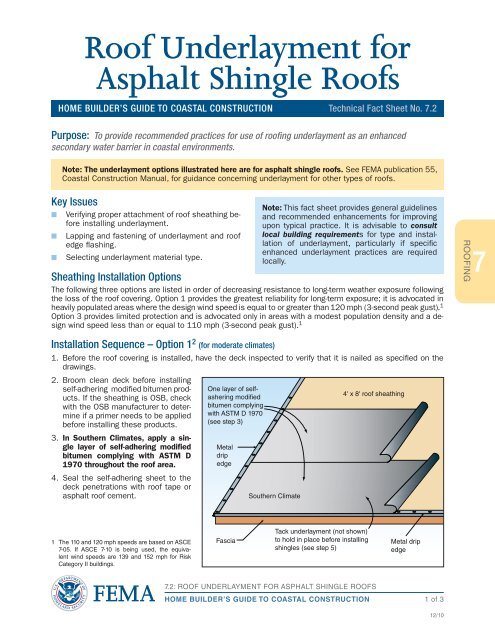FEMA P-499: Home Builder's Guide to Coastal Construction
FEMA P-499: Home Builder's Guide to Coastal Construction
FEMA P-499: Home Builder's Guide to Coastal Construction
Create successful ePaper yourself
Turn your PDF publications into a flip-book with our unique Google optimized e-Paper software.
Roof Underlayment for<br />
Asphalt Shingle Roofs<br />
HOME BUILDER’S GUIDE TO COASTAL CONSTRUCTION Technical Fact Sheet No. 7.2<br />
Purpose: To provide recommended practices for use of roofing underlayment as an enhanced<br />
secondary water barrier in coastal environments.<br />
Note: The underlayment options illustrated here are for asphalt shingle roofs. See <strong>FEMA</strong> publication 55,<br />
<strong>Coastal</strong> <strong>Construction</strong> Manual, for guidance concerning underlayment for other types of roofs.<br />
Key Issues<br />
n Verifying proper attachment of roof sheathing before<br />
installing underlayment.<br />
n Lapping and fastening of underlayment and roof<br />
edge flashing.<br />
n Selecting underlayment material type.<br />
Sheathing Installation Options<br />
The following three options are listed in order of decreasing resistance <strong>to</strong> long-term weather exposure following<br />
the loss of the roof covering. Option 1 provides the greatest reliability for long-term exposure; it is advocated in<br />
heavily populated areas where the design wind speed is equal <strong>to</strong> or greater than 120 mph (3-second peak gust). 1<br />
Option 3 provides limited protection and is advocated only in areas with a modest population density and a design<br />
wind speed less than or equal <strong>to</strong> 110 mph (3-second peak gust). 1<br />
Installation Sequence – Option 12 (for moderate climates)<br />
1. Before the roof covering is installed, have the deck inspected <strong>to</strong> verify that it is nailed as specified on the<br />
drawings.<br />
2. Broom clean deck before installing<br />
self-adhering modified bitumen products.<br />
If the sheathing is OSB, check<br />
with the OSB manufacturer <strong>to</strong> determine<br />
if a primer needs <strong>to</strong> be applied<br />
before installing these products.<br />
3. In Southern Climates, apply a single<br />
layer of self-adhering modified<br />
bitumen complying with ASTM D<br />
1970 throughout the roof area.<br />
4. Seal the self-adhering sheet <strong>to</strong> the<br />
deck penetrations with roof tape or<br />
asphalt roof cement.<br />
1 The 110 and 120 mph speeds are based on ASCE<br />
7-05. If ASCE 7-10 is being used, the equivalent<br />
wind speeds are 139 and 152 mph for Risk<br />
Category II buildings.<br />
Note: This fact sheet provides general guidelines<br />
and recommended enhancements for improving<br />
upon typical practice. It is advisable <strong>to</strong> consult<br />
local building requirements for type and installation<br />
of underlayment, particularly if specific<br />
enhanced underlayment practices are required<br />
locally.<br />
7.2: ROOF UNDERLAYMENT FOR ASPHALT SHINGLE ROOFS<br />
HOME BUILDER’S GUIDE TO COASTAL CONSTRUCTION<br />
1 of 3<br />
12/10<br />
ROOFING<br />
7


